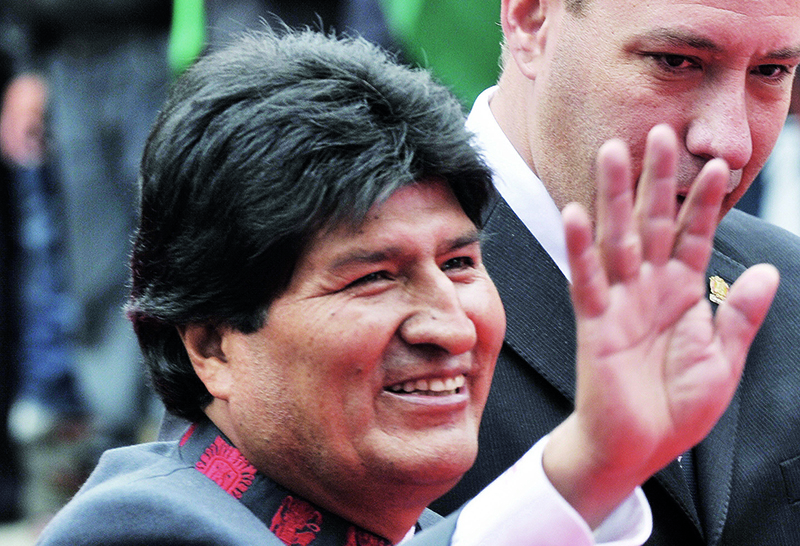Bolivia has made more economic progress since President Evo Morales took office in 2006 than in all the preceding 180 years, and not just thanks to the nationalization of its extensive oil and gas resources. Despite the collapse in world hydrocarbon prices, the economy grew a robust 5.2% last year, up by $34 billion over 2014’s results

Inevitably, even a casual mention of Bolivia in international policy forums is enough to trigger an impassioned exchange of opinions about its president, Evo Morales. Re-elected for a third time in October 2014, the support he still commands after nearly a decade in office is ratified by favorable opinion poll results of over 60%.
The easy way for his opponents to be dismissive is for them to point out that, well, after all, he is an Indian, from one of the 32 indigenous communities mentioned by name in the 2009 constitution of what is now, officially, the Plurinational State of Bolivia.
Together, Bolivia’s Indians constitute 47% of the population, the half that was systematically exploited, repressed, and denied basic human rights before and after Bolivia won its independence from Spain in 1825. They were the people who had no voice and no hope, recalls President Morales, but fortunately, “there was a participatory, peaceful, democratic way” of dealing with their grievances.
“What is it we keep hearing from some of our intellectuals? That if you want a revolution, you better stock up on bullets. But social change movements, especially the campaign for Indian rights, showed us that revolutions can be made with ballots instead of bullets, and that in voting, the important thing is to make people aware of what’s at stake,” says Mr. Morales.
Delivering essential social services to a country that not long ago was locked in a dead heat with Haiti as the hemisphere’s poorest keeps Bolivia’s president and people on the same political page, notes Dr. Hector Arce, the Attorney General. The number of people living in extreme poverty has been slashed by half, from 36% to 18%, and the president has pledged to get it down to a single digit before he leaves office in 2020.
“Economic growth came from behind to finish second in Latin America in 2014, at a little over 5%. If we were not landlocked, that would likely add 2% more,” says Dr. Arce.
ECLAC, the Economic Commission for Latin America and the Caribbean, forecasts another 5.5% rise in Bolivia’s GDP when the numbers for 2015 are in, and the government wants to ensure that revenues continue to revert to the citizenry. One in every three Bolivians receives some type of assistance from the state, including scholarships, pensions or prenatal care for pregnant women.
All that priority spending on social services pushes up the indicators but Economy Minister Luis Arce remains convinced that for these services to become available, nationalizing the country’s oil and natural gas reserves was not just a justifiable move, but also a just one.
“Wealth generated by our natural resources ended up with the transnational companies – mines, hydrocarbons, electricity, water – all were in foreign hands,” says the minister. In May 2006, President Morales ordered the nationalization of all assets belonging to petroleum industry giants and sent in the Army to “protect” the gas fields.
It was a bold move and it worked because the government proved as good as its word and channeled those revenues – around $6 billion – into the public welfare sector. This, living standards apart, triggered increased demand for basic services such as water, electricity and communications as well as for consumer goods in search of an untapped market.
It was in that context of confidence that officials decided the time had come for a national flag-carrier to reach out to the rest of the world and since its “take off” in 2009, Boliviana de Aviación – “BoA” as the government-owned airline is known – has exceeded all expectations.
“We surprised even ourselves how quickly we doubled our best forecasts,” says BoA General Manager Ronald Casso. “We were aiming for five aircraft in service in five years’ time, but we’ve reached that milestone with a fleet of 11 planes, double the routes and close to an 80% market share.”
It was a market nobody thought existed, but it began to emerge after Bolivians acquired the discretionary spending power to visit or be visited by expatriate family members settled abroad. Service to Madrid and Miami began last November. New routes to Havana and Caracas are in the works, though the immediate priority is Washington D.C. and enhancing cargo transport operations, as the U.S. remains Bolivia’s principal trading partner (excluding hydrocarbons). But 90% of BoA’s flights and 95% of its passengers originate inside the country.
As it happens, Mr. Casso was put in charge of preliminary planning for the airline in 2007, two years before its maiden flight, and so had good reason to be satisfied last year when BoA was approved for certification by IATA, the international air transport regulatory body. Like everyone else, in my university days I had great plans, dreams if you will, and it’s been my privilege to have seen so many of them come true,” says BoA’s pioneering GM.
Will BoA planes someday be bringing people to explore the pre-Colombian remains scattered across Bolivia’s Andean highlands, its UNESCO Heritage sites, or exotic nature and wildlife reserves? Marko Machicao, who currently holds the Cultures and Tourism portfolio in the Morales cabinet, says the answer is yes, once the infrastructure is in place to accommodate them.
“Tourism in Bolivia is something new as a significant element of public policy,” says the minister. “It took time for people to understand its multiplying effect on the economy in areas such as public transportation, handicrafts, gastronomy, etc. But in 2010 a law was passed allowing the sector access to external financing and granting the state a role in its development.”
0 COMMENTS